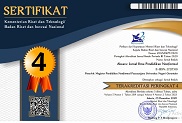Pengaruh Innovation, Entrepreneurial Desirability, Entrepreneurial Feasibility, Terhadap Entrepreneurial Intention
Abstract
Keywords
Full Text:
PDFReferences
Ahmadi, A. (2009). Psikologi Sosial . Jakarta: PT Rineka Cipta.
Ajzen, I. (2012). The Theory of Planned Behavior (Handbook of Theories of Social
Psychology). London, UK: Sage.
Al Rafisqy, Z. G. (2017, Oktober 11). Skala Pengukuran dalam Ilmu Statistik Lengkap
Contoh. Retrieved from Ekspektasia: https://ekspektasia.com/skala-pengukuran/
Alma, B. (2013). Kewirausahaan. Bandung: Alfabeta.
Arikunto, S. (2010). Prosedur Penelitian Suatu Pendekatan Praktik. Jakarta: Rineka
Cipta.
Azwar, S. (2013). Sikap Manusia Teori dan Pengukurannya (Edisi ke-2). Yogyakarta:
Pustaka Pelajar.
Baporikar, N. (2015). Handbook of Research on Entrepreneurship in the Contemporary
Knowledge-Based Global Economy. India: IGI Global.
Basu, A., & Virick, M. (2009). Assessing Entrepreneurial Intentions Amongst Students:
A Comparative Study. Peer Reviewed Papers.
Bungin, H. B. (2017). Metodologi Penelitian Kuantitatif: Edisi Kedua. Jakarta: Kencana.
Bungin, H. B. (2010). Metodologi Penelitian Kuantitatif: Komunikasi, Ekonomi, dan
Kebijakan Publik serta Ilmu-ilmu Sosial lainnya. Jakarta: Kencana.
Byabashaija, W., Katono, I., & Isabalija, R. (2011). The Impact of College
Entrepreneurial Education on Entrepreneurial Attitudes and Intention to Start a
Business in Uganda. Journal of Development Entrepreneurship, 8.
Bygrave, W., Zacharakis, A., & Corbett, A. (2017). Entrepreneurship. Hoboken, New
Jersey: Wiley.
Daryanto. (2012). Pendidikan Kewirausahaan. Yogyakarta: Gava Media.
Engle, R., Dimitriadi, N., Gavidia, J., Schlaegel, C., Delanoe, S., & Alvarado, I. (2010).
Entrepreneurial Intent a Twelve-country Evaluation of Ajzen's Model of Planned
Behavior. International Journal of Entrepreneurial Behavior & Research, 16, 35-
Fahmi, I. (2014). Kewirausahaan Teori, Kasus dan Solusi. Bandung: Alfabeta.
Ferreira, J. J., Raposo, M. L., & Rodrigues, R. G. (2012). A Model of entrepreneurial
Intention. Journal of Small Business and Enterprise Development, 424.
Fishbein, M., & Ajzen, I. (2010). Predicting and Changing Behavior: The Reasoned
Action Approach. New York: Psychology Press (Taylor & Francis).
Fornell, C., & Larcker, D. (1981). Evaluating Structural Equation Models with
Unobservable Variables and Measurement Error. Journal of Marketing Research,
, 39-50.
Gerungan, D. W. (2012). Psikologi Sosial. Bandung: Refika Aditama.
Ghozali, I. (2009). Ekonometrika - Teori, Konsep dan Aplikasi dengan SPSS 17. Badan
Penerbit Diponegoro.
Ghozali, I. (2011). Aplikasi Analisis Multivariate Dengan Program IBM SPSS 20 (Edisi
. Semarang: Universitas Diponegoro.
Ghozali, I. (2016). Aplikasi Analisis Multivariete IBM SPSS 23 Edisi 8. Semarang: Badan
Penerbit Universitas Diponegoro.
Ghozali, I., & Latan, H. (2015). Partial Least Squares : Konsep, Teknik, dan Aplikasi
Menggunakan SmartPLS 3.0. Semarang: Universitas Diponegoro.
Gunawan, A. A., & Sunardi, H. (2016). Pengaruh Kompensasi dan Disiplin Kerja
Terhadap Kinerja Karyawan Pada PT. Gesit Nusa Tangguh. Jurnal Ilmiah
Manajemen Bisnis, Vol 16 No. 1, 3.
Haus, I., Steinmetz, H., Isidor, R., & Kabst, R. (2013). Gender Effects on Entrepreneurial
Intention: A Meta-analytical Structural Equation Model. International Journal of
Gender and Entrepreneurship, 130-156.
Hisrich, R. (2008). Entrepreneurship (7th Edition ed.). Jakarta: Salemba Empat.
Huda, N. (2012). The Analysis of Attitudes, Subjective Norms, and Behavioral Control
on Muzakki's Intention to Pay Zakah. International Journal of Business and Social
Science, 271-279.
Iakovleva, T., Kolvereid, L., & Stephan, U. (2011). Entrepreneurial Intentions in
Developing and Developed Countries. Education + Training, 53, 353-370.
Joensuu, S., Viljamaa, A., Varamaki, E., & Tornikoski, E. (2013). Development of
Entrepreneurial Intention In Higher Education nd The Effect of Gender - A Latent
Growth Curve Analysis. Education + Training, 55, 781-803.
Kasiram, M. (2010). Metodologi Penelitian. Pamekasan: UIN MALIKI PRESS.
Kuncoro, M. (2009). Metode Riset Untuk Bisnis & Ekonomi. Jakarta: Penerbit Erlangga.
LaMorte, W. W. (2019, September 9). The Theory of Planned Behavior. Retrieved from
Behavioral Change Models: http://sphweb.bumc.bu.edu/otlt/MPHModules/
SB/BehavioralChangeTheories/BehavioralChangeTheories3.html
Linan, F., & Chen, Y.-W. (2009). Development and Cross-Cultural Application of a Specific
Instrument to Measure Entrepreneurial Intentions. Entrepreneurship Theory and Practice,
-21.
Maharani, S. (2016, January 28). Bisnis UKM Online Tumbuh 10 Kali Lipat. Retrieved from
Tempo.co: https://bisnis.tempo.co/read/740354/bisnis-ukm-online-tumbuh-10-kalilipat/
full&view=ok
Morissan, M. A. (2014). Metode Penelitian Survei. Jakarta: Kencana.
Nugroho, A., Masduqi, A., & Otok, W. (2014). Aplikasi Partial Least Square Structural Equation
Modelling untuk Menilai Faktor Pencemaran Air Kali Surabaya. ResearchGate, 139.
Patiro, S. P., & Budiyanti, H. (2016). The Theory of Planned Behavior, Past Behavior, Situational
Factors and Self - Identity Factors Drive Indonesian Entrepreneurs To Be Indebtedness.
DeRema (Development Research of Management) , 48.
Pramesti, I. A. (2019, February 6). Ekonomi Indonesia 2018 Capai Rp 14.837,4 T, Ini
Komposisinya. Retrieved from CNBC Indonesia:
https://www.cnbcindonesia.com/market/20190206140257-17-54058/ekonomi-indonesia-
-capai-rp-148374-t-ini-komposisinya
Riduwan. (2010). Skala Pengukuran Variabel-Variabel Penelitian. Bandung: Alfabeta.
Rizkiyani, A. H. (2015, Juni 24). Skala Likert sebagai Teknik Evaluasi. Retrieved from
Kompasiana: https://www.kompasiana.com/alifianahr/55283fcdf17e6111318b45a7/skalalikert-
sebagai-teknik-evaluasi
Santoso. (2009). Lingkungan Tempat Tinggal Menentukan Minat Berwirausaha. UMS, 11.
Sarwono, S. W. (2017). Pengantar Psikologi Umum. Jakarta: Rajawali Press.
Sarwono, W. S., & Meinarno, E. A. (2009). Psikologi Sosial. Jakarta: Salemba Humanika.
Sekaran, U., & Bougie, R. (2016). Research Methods for Business (A Skill - Building Approach)
- Seventh Edition. New York: Wiley.
Silalahi, U. (2010). Metode Penelitian Sosial. Bandung: Refika Aditama.
Singarimbun, M., & Effendi, S. (2008). Metode Penelitian Survei. Jakarta: LP3ES.
Siregar, S. (2014). Metode Penelitian Kuantitatif. Jakarta: Kencana.
Slamet, F. (2014). Dasar-dasar Kewirausahaan: Teori dan Praktik. Jakarta: Indeks.
Solesvik, M., Westhead, P., Kolvereid, L., & Matlay, H. (2012). Student Intentions to Become
Self-employed: The Ukranian Context. Journal of Small Business and Entreprise
Development, 19, 441-460.
Sugiyono. (2014). Metode Penelitian Kuantitatif, Kualitatif dan R&D. Bandung: Alfabeta.
Sukardi. (2011). Metode Penelitian Pendidikan: Kompetensi dan Praktiknya. Jakarta: Bumi
Aksara.
Suryana, Y., & Bayu, K. (2011). Kewirausahaan Pendekatan Karakteristik Wirausaha Sukses.
Jakarta: Kencana.
Swarjana, I. K. (2015). Metodologi Penelitian Kesehatan (Edisi Revisi). Yogyakarta: Andi.
Syukri, M., & Hinaya. (2019). Pengaruh Pertumbuhan Ekonomi, Pendapatan Asli Daerah, Dana
Alokasi Umum dan Dana Alokasi Khusus Terhadap Anggaran Belanja Modal Kabupaten
& Kota Provinsi Sulawesi Selatan. JEMMA (Journal of Economic, Management and
Accounting Vol 2 No.2 , 35.
Usman, H. (2015). Pengantar Statistik. Jakarta: Bumi Aksara.
DOI: http://dx.doi.org/10.37905/aksara.8.2.997-1010.2022
Refbacks
- There are currently no refbacks.
Copyright (c) 2022 Aksara: Jurnal Ilmu Pendidikan Nonformal

This work is licensed under a Creative Commons Attribution-ShareAlike 4.0 International License.
Publisher:
Magister Pendidikan Nonformal Pascasarjana Universitas Negeri Gorontalo
Jl. Soedirman No. 06 Gorontalo 96128 e-mail: jurnalaksara@ung.ac.id
http://ejurnal.pps.ung.ac.id







